GenCade Users Guide
Getting Started
This GenCade guide was developed in September 2010. Most of the screenshots used in this guide were created with the July 29, 2010, build of the SMS. The August 25, 2010, build was used to create the screenshots for the Developing Alternatives and Time-dependent Wave Transmission sections. This guide refers to GenCade_v1_066.exe as the most recent executable. Developers are constantly upgrading the SMS and GenCade executables, so a future version may look slightly different from this user guide.
A very simple example can be found here. This example will show all steps necessary to produce results and include a zip file with all of the input and output files that can be used to reproduce the results on another computer.
Setup GenCade in the SMS
GenCade is available in the SMS (Surface-water Modeling System) interface. To use GenCade, a working version of SMS 10.1 and executable for SMS 11.0 Development are necessary. The SMS 11.0 Development executable is copyrighted, so a registration code is necessary before using.
First, locate the GenCade executable on the machine. As of 17 November, the most recent GenCade executable is GenCade_v1_070.exe. Drop the executable into the models folder under SMS 10.1 as shown in Figure 1.
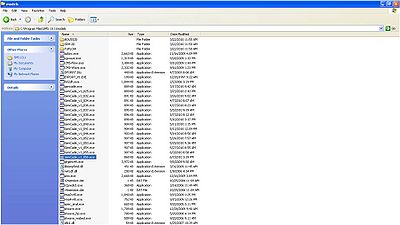
Once again, the capabilities of GenCade are only available in SMS 11.0 Development. If SMS 10.1 is already installed on the computer and a registration code for SMS 11.0 Development has been obtained, simply drag the SMS 11.0 executable into the SMS 10.1 folder (most likely in Program Files). Double-click on the SMS 11.0 executable to open SMS 11.0 Development. At this time, a prompt will open asking for the registration code. Before beginning to work in GenCade, go to Edit->Preferences. Select the tab File Locations and scroll down to GenCade under Model Executables. Click the button under Executable located directly to the right of GenCade. If GenCade has not been used previously, the button will most likely say BROWSE. After selecting this button, find the latest GenCade executable on the computer and select. The row to the right will specify the location of the executable which will be used to run GenCade (Figure 2).
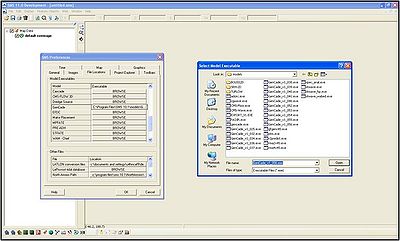
Set the current projection
GenCade uses a real world coordinate system, so it is necessary to set up the current projection upon opening the SMS. Aerial photos, shorelines, and other georeferenced files can be opened in the SMS. Go to Edit->Projection and define the current projection (Figure 3). This will ensure all shorelines, structures, wave gages, and other important features are mapped correctly. In many cases, the file may be georeferenced correctly without defining the current projection; however, it is a good idea to define the projection in all cases.
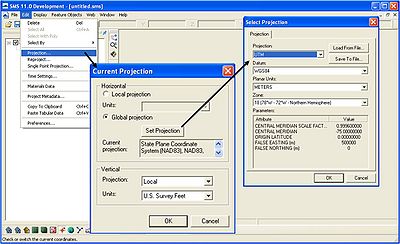
Reproject current projection
In some cases, the shorelines and the aerial photo may be in different coordinate systems. A user may also wish to use a different coordinate system for GenCade than the coordinate system of the aerial photo. To change the projection, go to Edit->Reproject. A new window will open where the current projection and new projection can be specified (Figure 4).
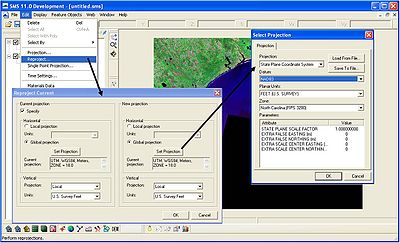
Preparing Input Files
Initial shoreline
Before dragging a file into the SMS interface, right click on default coverage under Map Data in the left panel. Select Type->Models->GenCade. To bring in a shoreline or regional contour as a *.cst, the original text file must be modified. See Figure 5 for the required format. The first number in the third row represents the number of points in the file. The other numbers in the first three rows will remain the same. This is similar to the old GENESIS format.
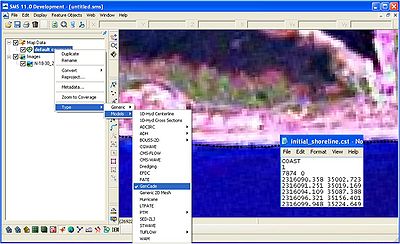
Once the shoreline is represented in the interface, click the Select Feature Arc button and double-click on the shoreline. The GenCade Arc Attributes will open. Select Initial Shoreline and click OK (Figure 6). Now the shoreline is defined.
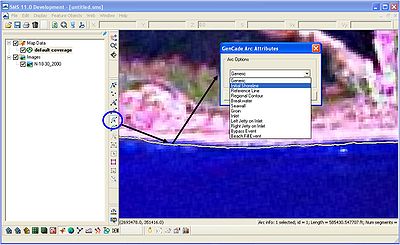
Regional contour or additional shorelines
In some cases, it may be necessary to include a regional contour or additional shorelines. Right-click on Map Data and select New Coverage. A window will open; scroll down and select GenCade as the coverage type (Figure 7). Open the regional contour in the interface, and click on the Select Feature Arc button. After double-clicking on the regional contour, select Regional Contour as the Arc Option in the GenCade Arc Attributes window (Figure 8). Additional shorelines can be added in a similar fashion.
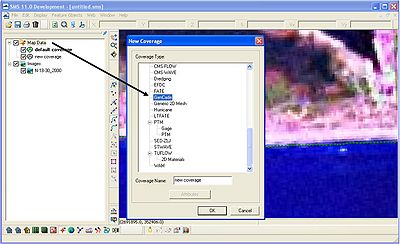
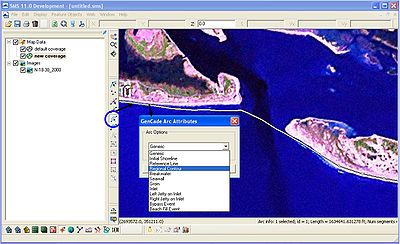
Merge coverages
After the initial shoreline and regional contour have been loaded and defined in the SMS interface, it is necessary to merge the two lines in a single coverage. All structures, inlets, wave gages, and other features will be created in this single coverage. Highlight both the default coverage (initial shoreline) and the new coverage (regional contour). Right-click and select Merge Coverages (Figure 9). This can be done by hitting ctrl on the keyboard and clicking on both coverages. A window will open asking "Do you want to delete the coverages used to make the merged coverage?" By selecting no, the initial shoreline and regional contour will remain in the interface and if a problem occurs, these coverages can be merged again. It may be necessary to redefine the shoreline and regional contour in this new coverage.
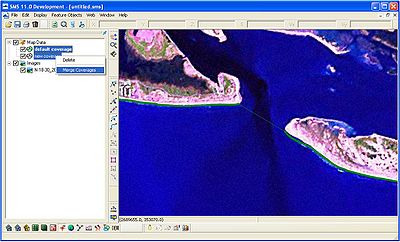
Grid Setup
Orientation and cell size
After merging the shoreline and regional contour into one coverage, the grid can be setup. If the user knows the what length grid to use, it is advisable to do this before adding any features to coverage. To manually draw the grid frame, click on the Create 2-D Grid Frame. The GenCade grid frame will be purple and have an arrow at one end. If a person was walking down the grid to the arrow, the water would be to the left and the land would be to the right. For example, if the GenCade grid arrow was pointing south, the water would be to the east (left) and the land would be to the west (right). The grid can be modified by clicking the Select 1-D Grid Frame and double-clicking on the square in the center of the purple grid line. The Grid Frame Properties window will open, and the Origin X, Origin Y, Angle, and I size can be modified (Figure 10). The I size is the length of the grid. The cell size can be constant or variable. If the user chooses to change the cell size under define cell sizes, the number of cells will change accordingly.
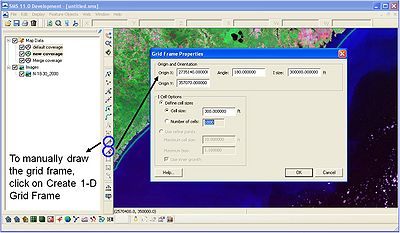
Inlets, shoals, jetties, and dredging
To create an inlet, select the Create Feature Arc button and draw a line from one side of the inlet to the other (Figure 11). This is why it is helpful to have a high quality aerial in the background. Once the inlet is drawn, click on the Select Feature Arc button and double-click on the line representing the inlet. The GenCade Arc Attributes window will open. Select Inlet and click on Attributes. This will open the Inlet Reservoir Model window. The inlet can be named, shoal volumes defined, and dredging added. Click on the Volume button to add the initial and equilibrium shoal volumes for the ebb, flood, left bypass, left attachment, right bypass, and right attachment. Similarly, in the dredging window, the user can define the beginning date, the ending date, the volume, and the shoal to be mined (Figure 12). After clicking OK, the line representing the inlet will turn blue.
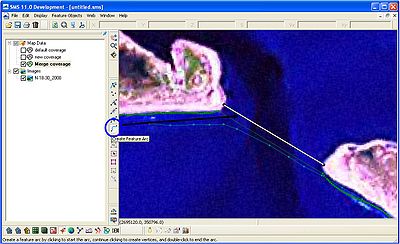

A jetty can be drawn at the inlet after selecting the Create Feature Arc button. After drawing the jetty, click on the Select Feature Arc and double-click on the line representing the jetty. When the GenCade Arc Attributes window opens, select either Left Jetty on Inlet or Right Jetty on Inlet (remember the left jetty is to the left of a person standing on land) and click on Attributes. A new window will open where user can choose the permeability, select diffracting or non-diffracting, and include a seaward depth (Figure 13). The line representing a jetty will also turn blue.
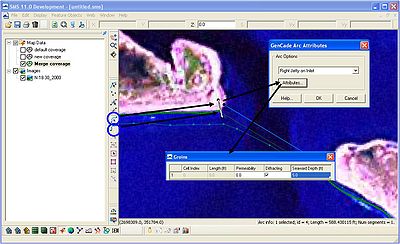
Beach fills
Beach fills can be drawn in the same way as inlets. Select the Create Feature Arc button to draw the beach fill. Beach fills can be drawn directly on the shoreline or slightly offshore. If there are many beach fills in one location during the simulation, each beach fill should be placed slightly offshore so they do not overlap. After each beach fill is drawn, click on the Select Feature Arc and double-click on the line representing the beach fill. Select the Beach Fill Event after the GenCade Arc Attributes window opens. For each beach fill, add the starting and end dates and the added berm width (Figure 14). After selecting OK in the GenCade Arc Attributes window, the line representing the beach fill will turn green.
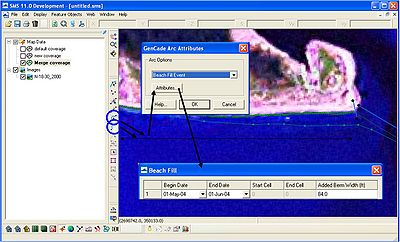
Groins
Once the location for a groin is chosen, select the Create Feature Arc button. In most cases, the arc representing the groin will cross the regional contour and initial shoreline. Do not draw either end of the groin near the regional contour or initial shoreline. When this occurs, the node from the groin will connect to the initial shoreline or regional contour. This will divide the regional contour or initial shoreline into two separate arcs, where only one of the arc will be considered the regional contour or initial shoreline. At this point, GenCade does not have the capability to identify multiple arcs for the initial shoreline or regional contour. The best way to prevent this (at this time) is to save often, reopen the project, and start at the step previously saved. After drawing the feature arc for the groin, click on the Select Feature Arc button. The GenCade Arc Attributes window will open. Select groin in the Arc Options menu and click on Attributes. The window for groins includes the permeability and seaward depth (in the user specified units). The user may also decide "Diffracting" or "Non-diffracting" for the groin.
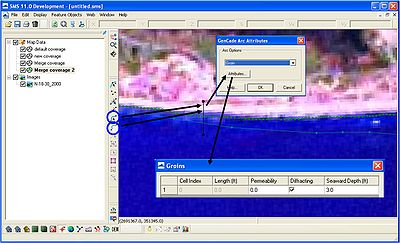
Detached Breakwaters
A detached breakwater is created by selecting the Create Feature Arc button and drawing the arc representing the detached breakwater. Click on the Select Feature Arc button and double-click on the detached breakwater. The GenCade Arc Attributes window will open. Scroll down to Breakwater and click on Attributes. The depth at each end of the detached breakwater can be enter in the Detached Breakwater window.There is a pull-down window for wave transmission which includes constant transmission and three equations for time-dependent wave transmission: Ahrens, Seabrook and Hall, and d'Angremond.
Constant Transmission
Under the Transmission bar, select constant. The last column in the detached breakwaters window is coeff/perm/atts. For constant transmission, this represents the permeability of the detached breakwater. Once all necessary information is entered, click OK. The detached breakwater will turn blue.
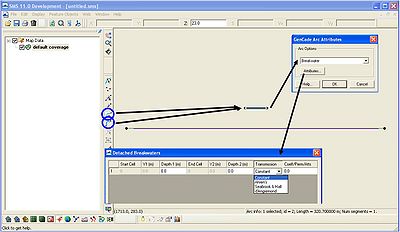
Time-dependent Wave Transmission
Ahrens
After selecting Ahrens under Transmission in the Detached Breakwater window, the final column (coeff/perm/atts) will become selectable. Once the mouse clicks on this box, the Breakwater Attributes window will open. For Ahrens, the required values include freeboard to MSL, width, seaward side slope, shoreward side slope, and the D50 of the armor stone. Click OK, and the detached breakwater should turn blue.

d'Angremond
Another equation that can be used for time-dependent wave transmission is d'Angremond. Similarly to selecting Ahrens, click on the final column of the Detached Breakwaters window which should know say Atts. For d'Angremond, the freeboard to MSL, width, seaward side slope, shoreward side slope, and permeability are required.
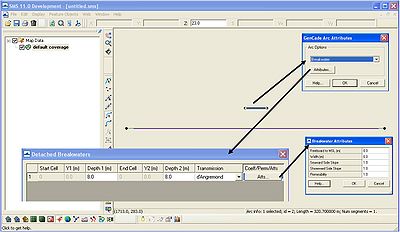
Seabrook and Hall
Seabrook and Hall can also be used for time-dependent wave transmission. After selecting Seabrook and Hall in the Detached Breakwaters window, click on Atts in the final column. The Breakwater Attributes window will open, and the freeboard to MSL, width, seaward side slope, shoreward side slope, and D50 of the armor stone can be entered.
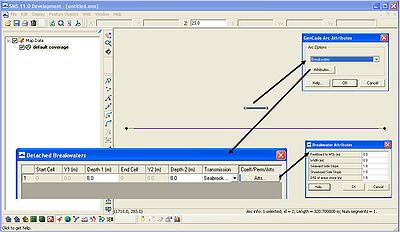
Water Level File
Regardless of the equation used for time-dependent wave transmission, water level data is required. Once attributes for the breakwaters are assigned and the conceptual model is completed, convert to 1D grid. In the GenCade menu, go to Edit Water Level Data. This window includes two columns: the date and water level. The date needs to be entered in the same format as for wave information (section 2.3.6). The best way to develop the water level file is to use Excel or a computer program, and paste the list of events into GenCade.
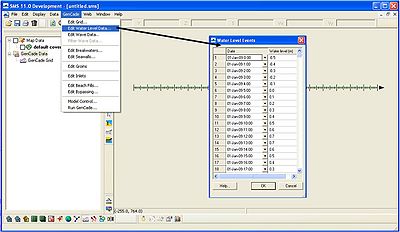
After saving the project, the water level file (*.wl) will appear in the same folder as all of the other input files. The *.gen file will include this as an input file. The detached breakwaters section of the *.gen will include all of the variables entered for the detached breakwater.
Wave Data
There are several ways to represent wave gages in the conceptual model. If the coordinates for the wave gages are in the same coordinate system as the conceptual model, it is very easy to bring in the location of the gages. Drag the file with the coordinates representing the wave gages into the SMS interface. The Open File Format window will open. Select Use Import Wizard and click OK. Follow the direction for the File Import Wizard and select OK. The wave gage locations will be represented as scatter data. Simply select the Create Feature Point button in the conceptual model and draw a feature point directly on top of each point. Now the wave gage locations are represented in the model.
If the coordinates for the wave gages are in a different coordinate system than the GenCade conceptual model, the process to bring in the locations representing the gages is slightly different. Go to Single Point Projection under the Edit menu. The Reproject Single Point window will open. In the Convert from window, choose the projection of the wave gage. In the Convert to window, specify the projection of the GenCade conceptual model. At the bottom of the window, enter the coordinates of the wave gage and check create feature point. Once the window is closed, the location of the wave gage will become a feature point in the GenCade conceptual model. This process will need to be repeated for each wave gage.
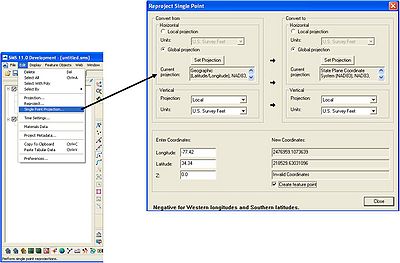
Once the wave gages are represented in the conceptual model as feature points, click on the Select Feature Point button and double click on the point representing the wave gage. In the Refine Point window, check wave gage and click on options. The wave gages window will open and the user can specify the depth of the wave gage. After clicking Data, the Wave Events window will open. There are four columns in this window: Date (month, day, year, and time), Ho (the wave height is always in meters), Period (in seconds), and Direction (in degrees). The direction is shore (grid) normal. In most cases, the user will need to convert to grid normal outside of the SMS interface. It is expected that the ability to input wave data in meteorological, oceanographic, or local coordinates will added to the SMS interface during this FY.
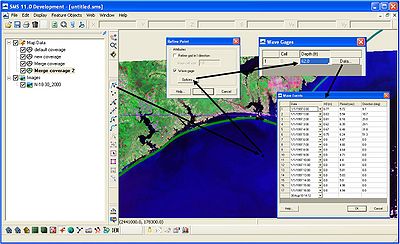
For the SMS to read the wave information correctly, the information must be copied and pasted in a specific format. The easiest way to do this is to bring the wave information into Microsoft Excel. The first column will include the month, day, year, and time. The date must be in the format of 1/1/1997 0:00. The wave height, period, and direction are included in the proper column. An example of this format is shown in Figure 18. Before copying the wave information to GenCade in the SMS interface, the user must clean the information. Since the waves are read in as shore (grid) normal, the wave direction must be between -90 and +90 degrees. If wave direction is coming from shore in the raw wave data, it is necessary to make the wave height and direction zero for GenCade.
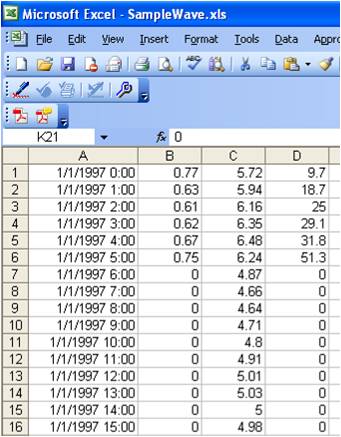
Convert to 1-D Grid
Once all of the inlets, structures, beach fills, wave gages, etc. have been added to the conceptual model, go to the merged coverage (location where all arcs were added), right click on the name, click on convert, and select Map->1D Grid. A window will open which show the origin and orientation of the GenCade grid and the different cell options. This is the same window used when manually drawing and modifying the grid frame. In many cases, a constant cell size will be sufficient to give reasonable results. Either the cell size or number of cells can be changed. The other blank will change based on the total length of the grid (I size). The default cell size is 10 ft, but a cell size of at least 15 to 20 feet is suggested to reduce instabilities. In other cases where one specific region of the GenCade grid need more refinement, variable grid resolution is available.
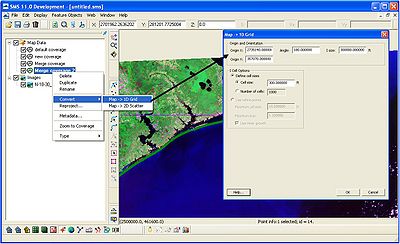
GenCade Files, Menu, Model Setup, and Execution
GenCade Input Files
There are several input files necessary to run GenCade. These will be created once the GenCade project is saved. The *.gen is the control file. This file records all of the information for structures, inlets, beach fills, boundary conditions, wave gages, and model setup. While this file can be opened, it is recommended that the user not make any changes directly to the *.gen file. The *.shi and *.shr are in the same format. The *.shi represents the initial shoreline (initial shoreline distance from the baseline at each cell). The *.shr gives the distance from the baseline to the regional contour. If a regional contour was not created, this file will not exist. The *.wave files include all of the wave information. There will be one *.wave file for each wave gage.
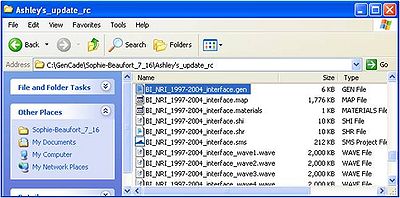
GenCade Menu
After the user converts to the 1-D grid, the GenCade menu will appear (between Data and Web in the menu). This menu can be used to make minor changes to the project. An example of a minor change to make in GenCade is modifying the cells representing left and right bypassing under the Edit Inlets menu. If the user is calibrating the model, it is best to return to the conceptual model to make changes. Changes made in the conceptual model can be applied to multiple projects, changes made to the grid itself cannot.
Model Control
Model Control for GenCade is located under the GenCade menu. After clicking Model Control, a window will open with four tabs: Model Setup, Beach Setup, Seaward BC, and Lateral BC.
The simulation name and computational time is located under the Model Setup tab. The title of the simulation can be changed from SMS Simulation. Also, the start date, end date, time step, and recording time step can be specified.
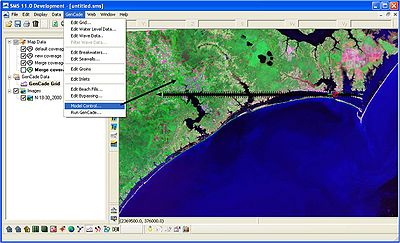
Sand and Beach Data and Longshore Sand Transport Calibration Coefficients are included in the Beach Setup tab. The Sand and Beach Data includes the effective grain size, average berm height and closure depth. K1 (primary calibration coefficient) and K2 (secondary calibration coefficient) are the longshore sand transport calibration coefficients. The K2 term is only active when there are strong wave height gradients. In most cases, K2 should be greater than K1. However, a sensitivity analysis for K1 and K2 should be conducted.
The Seaward BC tab includes the Input wave adjustments and other options. The input wave adjustments include height amplification factor, angle amplification factor, and angle offset. The other options include wave components to apply and number of cells in offshore contour smoothing window (ISMOOTH). Similar to K1 and K2, the value of ISMOOTH needs to be adjusted through a sensitivity analysis. Although 11 is the default for ISMOOTH, there is no recommended value. ISMOOTH needs to be large enough so that the local shoreline undulations are not reflected back on the shape of the offshore contour. Using an ISMOOTH value about 2-3 time the length of the detached breakwaters or about twice the between groins in a groin system is a good place to start.
Left and right lateral boundary conditions can be specified under the Lateral BC tab. Presently, GenCade has three boundary conditions available: pinned, moving, and gated. As of 21 October, only the pinned boundary condition is available in the SMS interface. The GenCade model has been updated to include moving and gated boundary conditions, so a user could modify the *.gen file to include a moving or gated boundary. Moving and gated boundary conditions will be included in the interface soon. Go to GenCade_Boundary_Conditions for more information and examples for each of the boundary conditions.
Running GenCade
Once all of information is set up in the GenCade grid and all of the parameters in model control have been updated, GenCade can be run. Please remember to save the project before running GenCade. If the project is not saved, the *.gen file will not be saved accordingly. To run GenCade, go to the GenCade menu and select Run GenCade. A window will open that will describe the simulation. This window will notify the user if an error has occurred. Although there is no time bar stating the amount of time left in the simulation, the window will show when GenCade has finished calculating each year in the time simulation. The window will alert the user when the model is finished and prompt to exit.
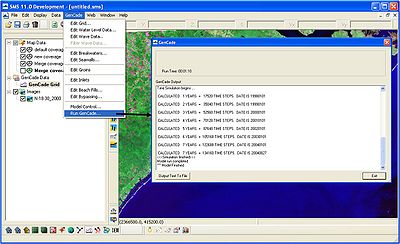
GenCade Output Files
During the GenCade simulation, three files will be created in the desired directory. These three files are the *.prt, *.slo, and *.qtr. The *.prt (print file) includes all information saved during the simulation. This file includes the shoreline position,shoreline change, breaking wave angle, offshore wave angle to the x-axis, and transport volume to the left and right after each year. The *.slo is the shoreline change file. Once this file is opened in SMS, the calculated shoreline can be viewed in the graphical window for each time step. The *.qrt file includes longshore sand transport in each cell for each time step.
Visualizing Results
As mentioned in the previous section, the *.slo file can be opened in SMS. Once the file has been opened in SMS, a box with the header "Time steps" will appear. An arc representing the calculated shoreline should appear in the grid window. In some cases the default color and size of the calculated shoreline are not easy to view. Go to Display->Display Options. Click on 1D Grid, and change the size and color of the shoreline. On some computer, the time steps listed for the calculated shoreline are in absolute date/time. To view the dates used in the simulation, right click on the words time steps and select time settings. Change the zero time to represent the first date in the simulation. Under time display, change absolute time/date to relative time. Each time step in the simulation can now be viewed.
Plots can now be viewed in SMS. Under Display, click on Plot Wizard. In the first window, select Shoreline as the plot type. Keep the active data set under data set and active time step under time step selected and click finish. A new window will appear showing the shoreline for the selected time step. The same process can be followed to view plots for shoreline change and rate of change.
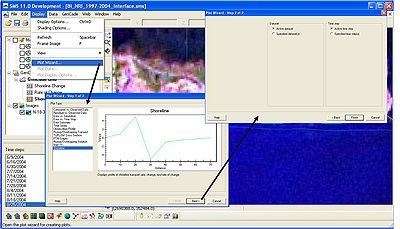
Some users may want to plot shoreline change in Microsoft Excel or something similar. All of the information collected during the simulation was saved in the *.prt file. After opening this file, find the shoreline change after X years (X being the total number of years in the simulation). Although the shoreline change is not in column format, the format can easily be changed with a simple code. If the case uses constant resolution, the user can type in the distance alongshore. In the case of variable resolution, there is an additional input file: *.shdx. Each number in this file represents the size of each grid cell. The numbers in the file can be converted to column format using Matlab or a similar programming language. Once the distance alongshore and the shoreline change are in Excel, then the shoreline change can be plotted.
It is also possible to use Excel to plot longshore transport and compare a calculated shoreline to a measured shoreline. In the *.prt file, longshore transport can be find by searching for "mean net annual transport." Please make a note of the units listed in the *.prt file. The longshore transport can be plotted in Excel in the same way as shoreline change. The SMS interface will soon support longshore transport as a plotting option. It is slightly more difficult to compare the calculated shoreline to a measured shoreline. First, save as a new project. Drag in the measured shoreline to SMS and name it either initial shoreline or regional contour (for this new saved project). Convert to 1-D grid again and save. This will save the measured shoreline as the regional contour or initial shoreline. Both the measured and calculated shoreline will need to be compared to the initial shoreline. The *.shi will list distance the initial shoreline is offset from the grid. The calculated shoreline can be found in the *.prt by searching for shoreline position after the total number of years in the simulation. These numbers will represent the distance offset from the GenCade grid. By saving the measured shoreline as the initial shoreline or regional contour, this allows SMS to produce an input file for this shoreline in the same format as the initial shoreline and calculated shoreline. All of these shorelines can be converted to column format and pasted into Excel. Then subtract the measured and calculated shorelines from the initial shoreline to get shoreline change for the measured and calculated shorelines. At this time, comparing a measured shoreline to a calculated shoreline is not supported in the SMS interface.
Developing Alternatives
There are several ways to begin developing alternatives. While calibrating the model, it may be necessary to refine the grid. Some examples of modifications necessary to develop alternatives include changing a small section of the regional contour, changing the initial shoreline, and adding new structures.
Minor Changes to Regional Contour or Initial Shoreline
After setting up and running the model and looking at the results, it may become necessary to make a minor modification to the regional contour or initial shoreline. For example, a user may need to smooth the initial shoreline near an unstructured inlet or change the regional contour to account for a large ebb shoal.
To make changes to the regional contour or initial shoreline, return to the merged coverage with all of the shorelines, structures, and wave gages under Map Data. Click on Select Feature Vertex and drag each node to the desired location. It is also possible to add new nodes by clicking the Create Feature Vertex button, adding nodes, and moving to the selected location. Extra nodes can be deleted are they are selected. Once the required updates to the regional contour or initial shoreline are made, right click on the merged coverage and convert Map to 1D Grid. Click on the new GenCade grid. The original initial shoreline or regional contour should be replaced with the new one.

Modify Existing Structures or Beach Fills
For some alternatives, extending a structure or enlarging a beach fill may be required. To extend a structure, click on Select Feature Point. Click on the node at the end of the structure and extend it to the desired length. Beach fills can be modified in the same way. Right click on the merged coverage and convert Map to 1D Grid.
Replace Initial Shoreline or Regional Contour
Some projects may require analysis for several different time periods which would require multiple initial shorelines. If the structures exist during multiple time periods and the wave gage data spans many decades, it may be easiest to replace the initial shoreline in the conceptual model. The same process can be used if a new regional contour is necessary. Do not delete the existing GenCade grid. Right click on Map Data, click New Coverage, and select GenCade. It is best to give the new coverage an identifiable name. Right click on this new coverage, scroll down to Type->Models->GenCade. Open the new shoreline or regional contour in the new coverage (Sections 2.2.1 and 2.2.2). Click on the Select Feature Arc button and define the arc. Right click on the new coverage and convert Map to 1D Grid. The new initial shoreline or regional contour will replace the original.

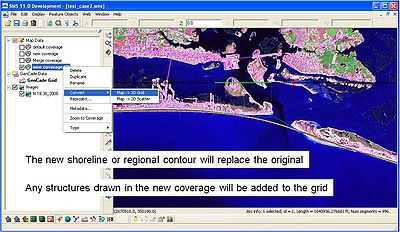
Add Structures or Beach Fills
When a project has many different alternatives, it may be necessary to add new structures. Instead of developing a new grid for each alternative, features can be modified or added to a base grid (with the initial shoreline, regional contour, wave gages, basic structures and beach fills). Right click on Map Data and select GenCade under New Coverage. Right click on this coverage and confirm that the model type is GenCade. In this new coverage, add new structures and beach fills by selecting the Create Feature Arc button. Specify the type of arc. Once all the new structures are included, right click on the new coverage and convert Map to 1D grid. The new arcs will be included in the GenCade grid. Additional structures or beach fills can also be added directly to the merged coverage (with the other arcs).
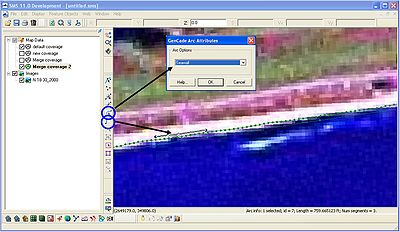
Modify Wave Gages
The instructions above regarding adding new features apply to adding new wave gages. However, sometimes the wave gage data needs to be modified. In reviewing the wave gage information, a user may find that a few of the dates or values may be incorrect. If only a few values need to be modified, click on the merged coverage and select the wave gage by clicking on the Select Feature Point and double-clicking on the point representing the wave gage. Click on Options and click on Data. Manually updated the incorrect wave information. Once finished, convert the Map to 1D Grid. The wave gage will now include the correct wave information.
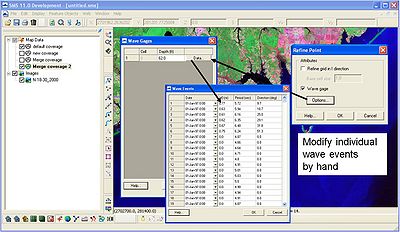
A user may also determine that an entire set of wave gage information maybe incorrect. This can occur by selecting the wrong wave gage when pasting values or incorrectly transforming the waves to shore-normal coordinates (grid-normal). This can be remedied by replacing the wave information.
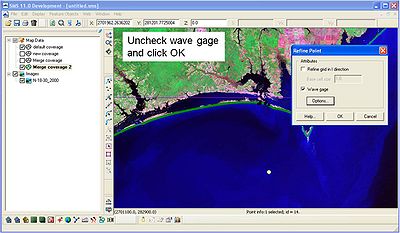
Variable Grid Resolution
A constant grid resolution is reasonable for most projects. However,there are some large scale projects that would benefit from variable grid resolution. The finer grid resolution can give more detail at certain locations in grid like near an engineering structure. When the map is converted to a 1D grid, one of the options under I Cell Options is Use refine points. This section refers to variable grid resolution.
First, it is necessary to determine which part of the grid needs a finer resolution. There are two ways to set up the finer grid resolution. The user can decide to user one point or two points. For both of these options, click the Create Feature Point button. If only one feature point is created, put the point at the location of interest. Click on the Select Feature Point button and double-click on the point. The Refine Point window will open (please note this is the same window used to specify a wave gage). Check the Refine grid in I direction and specify a base cell size. The base cell size is the the size of the cells near the refine point. This will be the smallest cell size in this location of the grid. Once the refine point is specified, right click on the coverage under map data and convert the map to a 1D grid. The Map->1D Grid window will open. Under I Cell Options, click the button to specify the Use refine points option. Type the maximum cell size and the maximum bias. The maximum cell size represents the largest cell size in the grid. Moving out from the one refine point, the cells will grow in size until a cell reaches the maximum cell size. The remaining cells will also be the maximum cell size. The maximum bias represents the amount each adjacent cell grows. For example, the default values is 1.10. This means each cell will grow 10%, so in a case with a base cell size of 10, the adjacent cells will have a size of 11. The cells will continue growing at this rate until a cell reaches the maximum cell size. In a case with only one refine point, do not select the Use inner growth option.
It is also possible to have a finer, constant resolution for a certain location within the grid. A groin field is a good example of a location on a grid that a finer, constant resolution could be necessary. For this case, select the Create Feature Point button and create points on either side of the desired finer resolution area. Click on the Select Feature Point button, double-click on each point, check the refine grid in I direction option, and choose a base cell size (make this number the same for both refine points). Once again, convert to 1D grid and select the use refine points options. Follow the same procedure as the case with only one refine point for the maximum cell size and maximum bias. If the use inner growth option is left unchecked, the cells between each refine point will be constant (at the same cell size as specified for each refine point). The cells outside of the two refine points will continue to grow based on the specified maximum bias number. If the use inner growth option is selected, the cells will also grow between the two refine points. If the two refine points are close together, the cell size most likely will not reach the maximum cell size, but the cells between the two refine points will be larger than the base cell size.
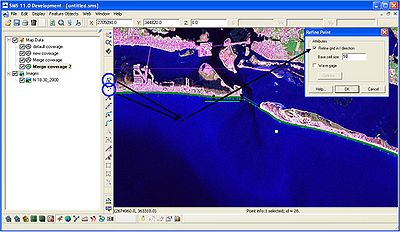
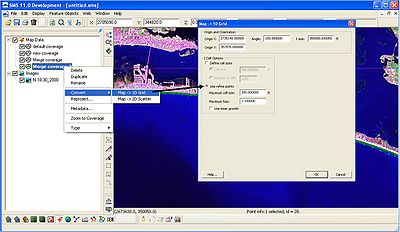
Once the use refine points option (variable grid resolution) is chosen in the Map->1D Grid window, the resulting GenCade grid will have variable resolution. After saving the project, the *.shdx file is also created. This file lists the size of each cell in the grid. This file is needed to make shoreline change or transport plots outside of SMS.
Return to GenCade Main Page.